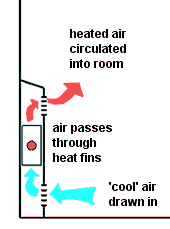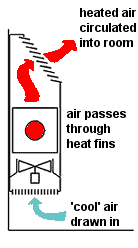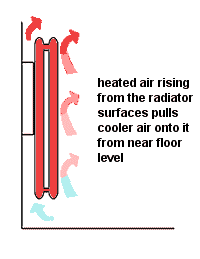Selecting the emitters for water central heating
skirting - fan assisted - radiators
There are a number of different types of emitters available for water central heating sytems :
'Skirting' heaters.
 Low level convector heaters which are positioned against the walls at floor level.
Low level convector heaters which are positioned against the walls at floor level.
These tend to have relatively low output per unit length but do even out the heat input around the room. .
To select the appropriate model for a given room, the heat requirement needs to be established (as per the example house) and the length of wall (or walls) to fit the heater needs to be calculated.
Then simply by dividing the heat requirement by the length of wall(s), the required heat output per unit length can be established. Reference to the manufactures data sheet will allow the appropriate model to be selected.
Although promoted a few decades ago, these skirting radiators never really caught on and are hard to find in the 21st century.
Fan assisted convectors.
 Very similar in basic principle to traditional radiators, the heat exchange unit is housed within a casing (usually wall mounted) and a low volume fan blows unheated air across the exchanger and into the room. In principle, because of the forced movement of air, more heat can be extracted from the circulating water and the room heated quicker.
Very similar in basic principle to traditional radiators, the heat exchange unit is housed within a casing (usually wall mounted) and a low volume fan blows unheated air across the exchanger and into the room. In principle, because of the forced movement of air, more heat can be extracted from the circulating water and the room heated quicker.
The fan is normally controlled by a thermostat which will stop the fan when the set temperature is achieved. One drawback is that by encasing the heat exchanger and fan, the units tend to be bigger than traditional radiators. Another drawback is that each heater requires a mains electricity supply to operate the fan.
To select the appropriate heater for a room, the heat requirement needs to be established (as per the example house). Reference to the manufactures data sheet will allow the appropriate model to be selected. It is worth remembering that any room can have more than a single heater, with rooms greater than 6 metres (18 ft) in any one direction, it is worth considering distributing the heat inputs to minimise the thermal gradient within the room.
Radiators.
 Radiators, as the term is normally used, are simple heat exchangers which distribute the heat by natural air circulation (hot air rises, so the heated air next to the surface of a radiator rises pulling cooler air up from the floor level). They are simple (very little can go wrong), easy to install and operate.
Radiators, as the term is normally used, are simple heat exchangers which distribute the heat by natural air circulation (hot air rises, so the heated air next to the surface of a radiator rises pulling cooler air up from the floor level). They are simple (very little can go wrong), easy to install and operate.
It is worth remembering that any room can have more than a single radiator, with rooms greater than 6 metres (18 ft) in any one direction. It is worth considering distributing a number of radiators to minimise the thermal gradient within the room.
Normally the manufacturer's data sheet will quote the output for when there is a temperature difference of 56 °C (100 °F) between the water in the radiator and the air in the room. Where the temperature difference is not 56 °C, the following correcting factors are necessary to determine the actual anticipated output from the radiator.
|
design temperature difference |
correcting
factor |
|
|
°C |
°F |
|
|
50 |
90 |
0.87 |
|
53 |
95 |
0.94 |
|
56 |
100 |
1.00 |
|
58 |
105 |
1.07 |
|
61 |
110 |
1.13 |
|
64 |
115 |
1.20 |
|
67 |
120 |
1.27 |
Where the outputs quoted on the manufacturers data sheet are based on temperature differences other than 56 °C (100 °F), the figure used should also be quoted on the data sheet as should the appropriate corrective factors. Always check these figures and adjust the quoted output figures before selecting a radiator.
To select the appropriate radiator for a room, the heat requirement needs to be established (as per the example house). Reference to the manufactures data sheet with any appropriate adjustment, will enable the appropriate size of radiator to be selected. However, it is very unlikely that any radiator will match the exact heat required, so select the first size of radiator above the heat requirement. A number of radiators will probably be suitable, each of different dimensions or with single or double panels. The final choice may depend the space available to mount the radiator.
Different manufacturers will quote slightly different outputs for seemingly similar sized radiators, so where possible always use the figures from the manufacturers data sheet. However, as a guide, the following table shows the approximate outputs for various sizes of panel radiators - where a manufacturers data sheet is not available, these figures can be used without much risk.
size (mm) |
output |
||||
single convector |
double convector |
||||
height |
width |
watt |
BTU |
watt |
BTU |
400 |
500 |
396 |
1350 |
759 |
2590 |
600 |
475 |
1620 |
911 |
3110 |
|
700 |
554 |
1890 |
1064 |
3630 |
|
800 |
633 |
2160 |
1216 |
4150 |
|
900 |
712 |
2430 |
1369 |
4671 |
|
1000 |
791 |
2700 |
1521 |
5190 |
|
1200 |
950 |
3240 |
1824 |
6225 |
|
500 |
500 |
479 |
1635 |
925 |
3155 |
600 |
576 |
1965 |
1109 |
3785 |
|
700 |
671 |
2290 |
1294 |
4415 |
|
800 |
768 |
2620 |
1480 |
5050 |
|
900 |
863 |
2945 |
1665 |
5680 |
|
1000 |
960 |
3275 |
1849 |
6310 |
|
1200 |
1152 |
3930 |
2220 |
7575 |
|
1400 |
1344 |
4585 |
2589 |
8835 |
|
1600 |
1536 |
5240 |
2960 |
10100 |
|
600 |
400 |
450 |
1535 |
865 |
2950 |
500 |
563 |
1920 |
1081 |
3690 |
|
600 |
674 |
2300 |
1297 |
4425 |
|
700 |
787 |
2685 |
1514 |
5165 |
|
800 |
900 |
3070 |
1731 |
5905 |
|
900 |
1013 |
3455 |
1946 |
6640 |
|
1000 |
1125 |
3840 |
2163 |
7380 |
|
1200 |
1351 |
4610 |
2595 |
8855 |
|
1400 |
1575 |
5375 |
2997 |
10225 |
|
1600 |
1801 |
6145 |
3461 |
11810 |
|
700 |
400 |
514 |
1755 |
982 |
3350 |
600 |
771 |
2630 |
1474 |
5030 |
|
800 |
1029 |
3510 |
1965 |
6705 |
|
1000 |
1287 |
4390 |
2456 |
8380 |
|
